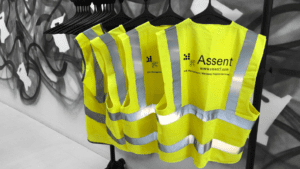Guest blog written by Russell Corlett at Peninsula.
All problems in a business are a leadership problem.
Success begins with leadership. Communication begins with leadership.
Health and safety starts with leadership.
For some of your employees your commitment to protecting their health and safety will be more important than the numbers on their payslip or the business’s success.
The Health and Safety at Work Act places a legal duty upon a management team in a business to protect the health, safety, and welfare of its employees and others who may be affected by their acts or omissions.
With this in mind, here are 2 primary questions that you, one of the leaders in your business, need to ask when you analyse your business’s health and safety procedures—before your employees ask you and find you with your jaw hanging low.
Do you know the dangers each of your employees faces?
You could write dissertation-length lists compiling the dangers an employee might face across the thousands of different jobs currently in operation. Sharp objects, heights, chemical exposure, high-speed and/or heavy equipment—just a handful of groups of threats that dozens of workers could be categorised into.
Assess
You need to identify the hazards that each of your employees will face. You need to identify the level of risk of the hazard. You need to provide first aid equipment and have a trained first aider on site.
You need to explore the options available to implement controls that could reduce or better, remove the risk.
Communicate
How do you reduce a risk? Let’s go with an easy one—association football. Fortunately, leg breaks are rare occurrences on the pitch these days. Officials have changed their perception of what is and is not a ‘fair tackle’ during the last two decades. Head injuries now require the referee to pause proceedings, and a player with a concussion must not take part in professional matches for a certain length of time to protect the player.
These are examples of controlling risk.
Monitor
You need to monitor this risk for changes over time. For example, if your employees are working near an environmental hazard that could become more potent based on the work done in its proximity, such as on a construction site, near a body of water, or an underground mine, you need to measure any changes to the risk level of the hazard on a regular basis. Is the work you have hired your employees to do going to make the landscape they’re working on dangerous?
Do your employees know the dangers that they face in their role?
The other side of the coin. A risk assessment is worthless if the person exposed to the hazard isn’t aware of the hazard, nor of the risk level. Or, perhaps most importantly, the method of reduction or removal of said risk.
As an employer, how many prospective employees have you interviewed? Got a rough number in your head? Good. Now take that number, and count how many of those prospective employees asked you in their interview about health and safety in your business. Or about the hazards they will face. Is that number now Lilliputian compared to the first number?
That’s a major problem. Interview advice articles everywhere informing you to ask about the ‘company ethos’ and why the interviewer enjoys working for the company—but no questions about basic health and safety. Time for you to step in.
Assess
Prepare an assessment for your employees that covers health and safety. On the assessment, you should ask critical questions of your employees such as:
- Are there any hazards in your job, and if so what are they?
- How likely would you deem the risk of each hazard on a scale of very unlikely (1) and very likely (5)?
- Is the work you are doing a hazard to other persons, for example passers-by?
- Do you know where the fire exits on your site of employment are? Where?
- Do you know where the nearest fire extinguisher is? Where?
- What equipment will you use during your work hours to complete your job?
- Who is the first aid person on site?
You get the picture. Add more as you see fit. This assessment will benefit your business threefold.
First, you get an extended view of what your employees see as hazards and their risk levels.
Two, you can identify where your perception of hazard and risk differs from your employees.
Three, a cause of the first two, you can identify where you need to improve your communication with your employees.
Communicate
The law obviously requires practitioners in a workplace to use equipment safely. The law also demands that people use safety equipment where necessary.
But does your employee know how to use the equipment? Full equipment training and extensive communication about first aid and health and safety responsibilities are effective indications on your part that you are committed to effective health and safety procedures.
Monitor
As an employer, you’re required by law to provide your staff with respiratory protective equipment when a breathing hazard is in effect; and where noise limits set by law are going to be exceeded, you should have hearing protection ready to hand out.
However, the law does not expect you the employer to provide safety boots, protective eyewear, hard hats, or even fire resistant clothing. But what you can do is make this equipment easier to acquire. Perhaps you’ll supply this equipment regardless.
How else can you monitor your employees’ knowledge of hazards and the risks (and levels of risk) of those hazards?
Health and safety. Briefings at the beginning of a project. Perhaps you could circulate details or training days to staff on a regular basis, and even establish the first Tuesday of the month at 11am as the health and safety hour.
Remember: health and safety starts with leadership.


